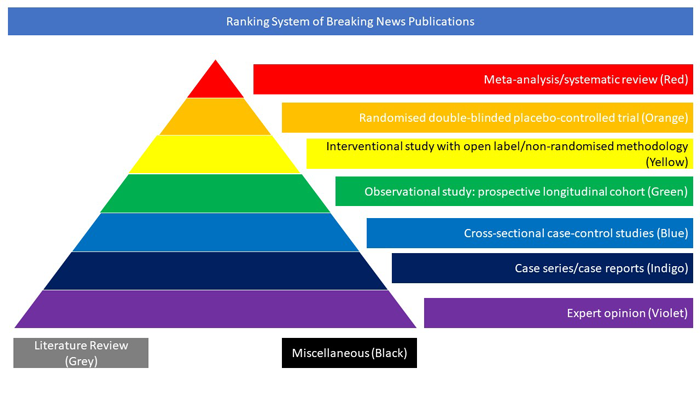Uniting to refine, filter and synthesise evidence in an infodemic
As the COVID-19 pandemic spread across the globe, clinicians were faced with a deluge of data derived from early observations, mid-term observational studies and randomised controlled trials. From a healthcare system perspective, the first waves of the pandemic completely disrupted healthcare––how it was conceptualised, organised and put into practice. For clinicians, the uncertainty regarding the safety and effectiveness of every procedure or treatment put the entire medical community in front of a long stairway to evidence-based medicine. When no evidence is available, clinicians rely on clinical judgement and a commitment to research.
During the pandemic, information about the effectiveness of COVID-19 therapies, procedures and public health interventions has been generated at an unprecedented rate. In 2020 alone, more than a thousand reports on COVID-19 appeared in international journals.1 This barrage of information has given rise to an infodemic: an abundance of data, both accurate and inaccurate, available everywhere. Extensive resources were required to sift through this evidence and synthesise it.
The European Academy of Neurology (EAN) responded to the pandemic and accompanying infodemic with several evidence-based initiatives. EAN is a non-profit scientific organisation that supports neurologists in Europe by producing and sharing knowledge on neurological disorders and diseases. It works closely with patients and scientific organisations to make sure that research and policy reflect the interests and perspectives of patients.
Monitoring information, fact-checking and quality control
In March 2020, EAN formed a dedicated task force of neurologists from all over Europe to develop a free access resource, EANcore COVID-19. This resource aims to help neurologists not just in Europe, but globally, to prepare for and manage the challenges of COVID-19. EANcore COVID-19 supports neurologists (both EAN members and non-members) by collating emerging data on neurological complications and the management of coexistent neurological diseases. Reports are then published from front-line doctors as well as updating the neurological community on the latest research and breaking news.
Data collation and publication was subject to critical appraisal and rapid evidence quality assessment. In particular, a dedicated team analysed the published literature, selecting articles with an impact on clinical practice. These articles were then to be reported on the EANcore COVID-19 breaking news page. To help reader understand the quality of evidence at a glance, all papers on the neurological manifestations of COVID-19 were colour-coded according to a hierarchy-of-evidence scale (see Figure 1).

EANcore COVID-19 activities go hand-in-hand with the promotion of evidence-based international studies and systematic reviews. As a result, the efforts of EAN––through the EANcore COVID-19 initiative and the EAN Scientific Panels (committees of experts responsible for EAN’s scientific output)––have allowed the publication of more than 20 papers on neurological disease and COVID-19. These include:
- EAN consensus statement for management of patients with neurological diseases during the COVID‐19 pandemic. This is a comprehensive definition of good clinical practice for patients with neurological diseases during the COVID-19 pandemic.2
- An early systematic review on neurological manifestations of COVID-19. This publication contains a proposal for strict reporting of case reports to avoid sensational language (‘myth-busting’).3
- Primary prevention of COVID-19: advocacy for vaccination from a neurological perspective. Working with the Neuro-COVID task force, EAN promoted the vaccination campaign rollout and raised awareness of inequalities in treatment, prevention and long-term consequences of neurological involvement in the context of COVID-19.4
Building evidence collectively
To help build an evidence base and prevent disparity at individual, national and supranational level, the NEuro-covid ReGistrY Consortium (ENERGY) was formed. ENERGY was intended to provide epidemiological data on neurological manifestations in patients with COVID-19, as reported by neurologists in all settings (i.e. outpatient services, emergency rooms and hospital departments). ENERGY helped to overcome the main limitation of the existing literature, namely, its basis on case reports and retrospective clinical series. These are sources that are open to selection bias.
The EAN ENERGY Registry has shed some light on the burden and general characteristics of neurological complications from COVID-19. Already more than 3,000 records are included in the Registry and preliminary reports show that any neurological sign/symptom has a negative impact on the prognosis of people with COVID-19. This highlights the need for careful assessment and management by all policymakers.5
The ENERGY protocol has been translated into different languages (Spanish, German, Italian, Russian and Portuguese) to facilitate its straightforward implementation in various countries around the world.
The ENERGY Registry has established a series of collaborations with different centres in the US, Europe and Latin America. This ensures representative inclusion of patients and strengthens worldwide partnerships to jointly overcome the devastating effects of pandemic.
Through collective participation and collaboration, we will be able to provide a vital resource for neurologists and other clinicians to improve care for COVID-19 patients.
Social media dissemination
EAN has also been active on social networks (Facebook and Twitter). Through its official accounts (@EANeurology), EAN disseminates the work of its Scientific Panels, interviews with members of its taskforce and the results of literature filtering and evidence syntheses. This gives both clinicians and patients a real-time overview of current research and the direction of future research.
References
1. Aviv-Reuven S, Rosenfeld A. Publication patterns’ changes due to the COVID-19 pandemic: a longitudinal and short-term scientometric analysis. Scientometrics. 2021;126:6761-6784. https://doi.org/10.1007/s11192-021-04059-x
2. von Oertzen TJ, Macerollo A, Leone MA, Beghi E, Crean M, Oztuk S, et al. EAN consensus statement for management of patients with neurological diseases during the COVID-19 pandemic. Eur J Neurol. 2021;28:7-14.
3. Romoli M, Jelcic I, Bernard-Valnet R, García Azorín D, Mancinelli L, Akhvlediani T, et al. A systematic review of neurological manifestations of SARS-CoV-2 infection: the devil is hidden in the details. Eur J Neurol. 2020;27:1712-1726.
4. Sellner J, Jenkins TM, Oertzen TJ, Bassetti CL, Beghi E, Bereczki D, et al. A plea for equitable global access to COVID‐19 diagnostics, vaccination and therapy: The NeuroCOVID‐19 Task Force of the European Academy of Neurology. Eur J Neurol. Epub 2021;5:ene.4741.
5. Chou SHY, Beghi E, Helbok R, Moro E, Sampson J, Altamirano V, et al. Global incidence of neurological manifestations among patients hospitalized with COVID-19: a report for the GCS-NeuroCOVID Consortium and the ENERGY Consortium. JAMA Netw Open. 2021;4:e2112131.
Authors
Dr Michele Romoli and Dr Vanessa Carvalho.
Disclaimer
The views expressed in this World EBHC Day Blog, as well as any errors or omissions, are the sole responsibility of the author and do not represent the views of the World EBHC Day Steering Committee, Official Partners or Sponsors; nor does it imply endorsement by the aforementioned parties.

Dr Michele Romoli is a clinical neurologist at the Bufalini Hospital in Cesena, Italy. His research focuses on systematic review methodology, meta-analysis and cerebrovascular disease.
Dr Vanessa Carvalho is a clinical neurologist at the University of Lisbon in Lisbon, Portugal. She is the former president of the resident and research fellow section of the EAN. Her clinical and research work is focused on movement disorders and neurogenetics.